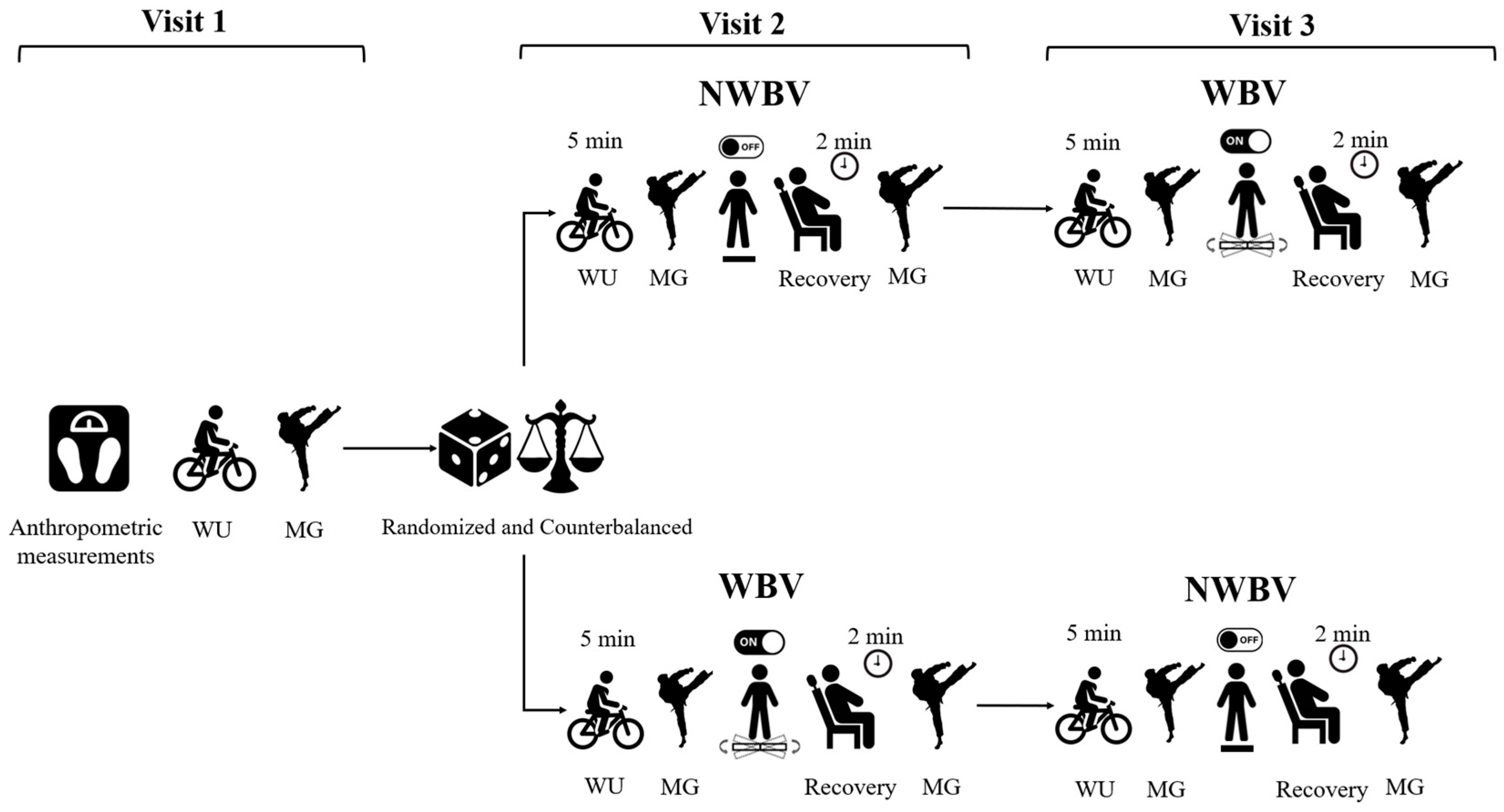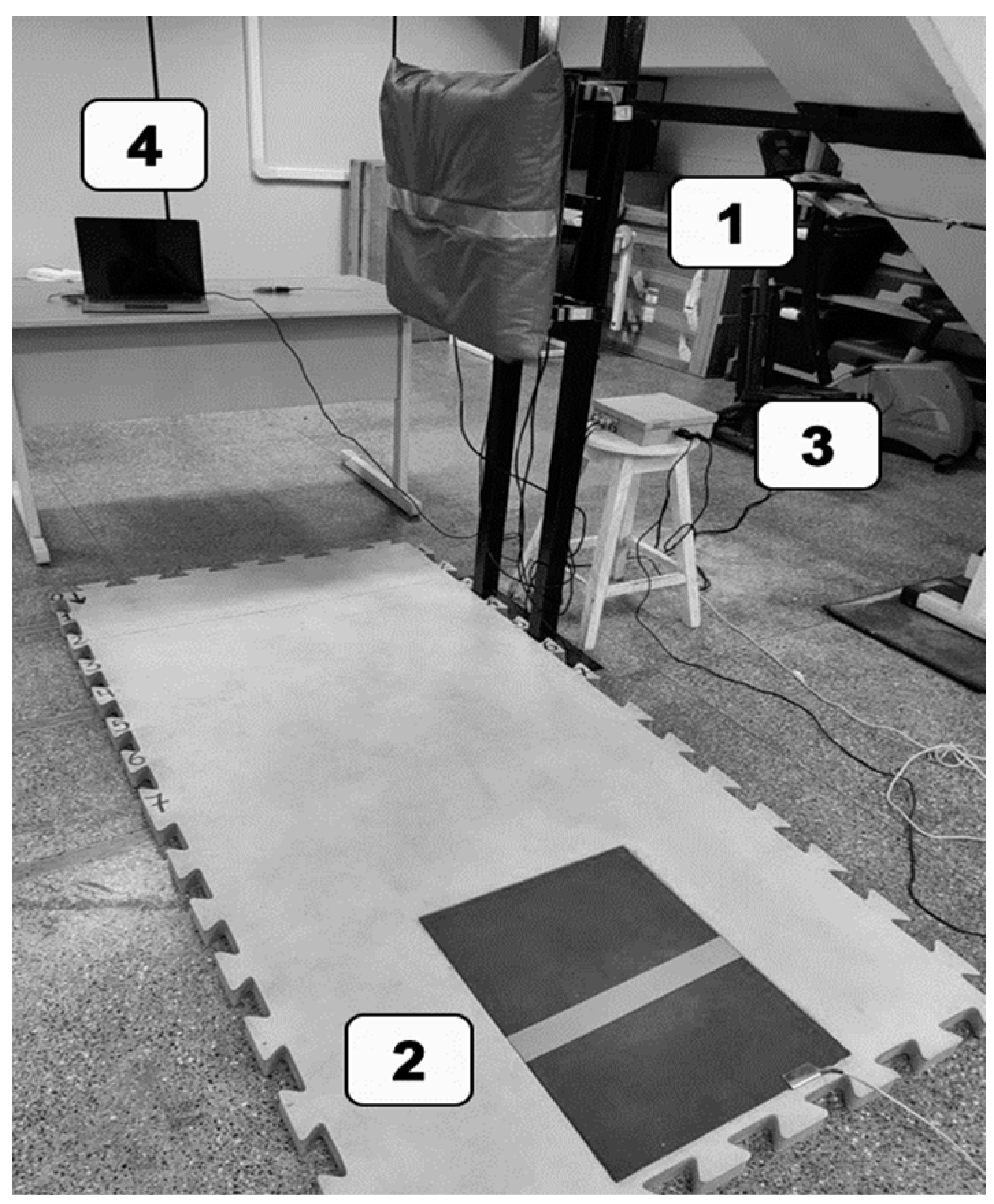Whole-Body Vibration (WBV) as a Conditioning Activity for Roundhouse Kick (mawashi geri) Performance in Karate
Abstract
1. Introduction
2. Materials and Methods
2.1. Participants
2.2. Study Design
2.3. Familiarization
2.4. Conditioning Activity Intervention
2.5. Mawashi Geri Test
2.6. Statistical Analysis
3. Results
4. Discussion
5. Conclusions
Author Contributions
Funding
Institutional Review Board Statement
Informed Consent Statement
Data Availability Statement
Conflicts of Interest
References
- Tabben, M.; Chaabène, H.; Franchini, E.; Tourny, C.; Chamari, K.; Coquart, J. The Influence of Karate Practice Level and Sex on Physiological and Perceptual Responses in Three Modern Karate Training Modalities. Biol. Sport 2014, 31, 201–207. [Google Scholar] [CrossRef] [PubMed][Green Version]
- Augustovicova, D.C.; Argajova, J.; García, M.S.; Rodríguez, M.M.; Arriaza, R. Top-Level Karate: Analysis of Frequency and Successfulness of Katas in K1 Premiere League. Ido Mov. Cult. 2018, 18, 46–53. [Google Scholar] [CrossRef]
- Spingolo, D.; Hartz, C.; Junqueira, C.; Longo, A.; Fayçal, H.; De Paula, M.; Jacinto, L.; Moreno, M. The Correlation of Anthropometric Variables and Jump Power Performance in Elite Karate Athletes. Artic. J. Exerc. Physiol. Online 2018, 21, 139–148. [Google Scholar]
- Pinelo, M. Training Variables Affecting Performance in Karate-Do. Habilidad Motriz. 2019, 53, 48–54. [Google Scholar]
- Błaszczyszyn, M.; Szczęsna, A.; Pawlyta, M.; Marszałek, M.; Karczmit, D. Kinematic Analysis of Mae-Geri Kicks in Beginner and Advanced Kyokushin Karate Athletes. Int. J. Environ. Res. Public Health 2019, 16, 3155. [Google Scholar] [CrossRef]
- Hariri, S.; Sadeghi, H. Biomechanical Analysis of Mawashi-Geri in Technique in Karate: Review Article. Int. J. Sport Stud. Health, 2018; in press. [Google Scholar] [CrossRef]
- Kindzer, B.; Danylevych, M.; Ivanochko, V.; Hrybovska, I.; Kashuba, Y.; Grygus, I.; Napierała, M.; Smoleńska, O.; Ostrowska, M.; Hagner-Derengowska, M.; et al. Improvement of Special Training of Karatists for Kumite Competitions Using Kata. J. Phys. Educ. Sport 2021, 21, 2466–2472. [Google Scholar] [CrossRef]
- Cuenca-Fernández, F.; Smith, I.C.; Jordan, M.J.; MacIntosh, B.R.; López-Contreras, G.; Arellano, R.; Herzog, W. Nonlocalized Postactivation Performance Enhancement (PAPE) Effects in Trained Athletes: A Pilot Study. Appl. Physiol. Nutr. Metab. 2017, 42, 1122–1125. [Google Scholar] [CrossRef]
- Blazevich, A.J.; Babault, N. Post-Activation Potentiation Versus Post-Activation Performance Enhancement in Humans: Historical Perspective, Underlying Mechanisms, and Current Issues. Front. Physiol. 2019, 10, 1359. [Google Scholar] [CrossRef]
- Boullosa, D. Post-Activation Performance Enhancement Strategies in Sport: A Brief Review for Practitioners. Hum. Mov. 2021, 22, 101–109. [Google Scholar] [CrossRef]
- González-Alonso, J.; Quistorff, B.; Krustrup, P.; Bangsbo, J.; Saltin, B. Heat Production in Human Skeletal Muscle at the Onset of intense Dynamic Exercise. J. Physiol. 2000, 524, 603–615. [Google Scholar] [PubMed]
- Håkon, A.; Erna, V.H.; Van den Tillaar, R. Effect of Postactivation Potentiation Induced by Elastic Resistance on Kinematics and Performance in a Roundhouse Kick of Trained Martial Arts Practitioners. J. Strength. Cond. Res. 2017, 32, 990–996. [Google Scholar]
- Ouergui, I.; Delleli, S.; Messaoudi, H.; Bridge, C.A.; Chtourou, H.; Franchini, E.; Ardigò, L.P. Effects of Conditioning Activity Mode, Rest Interval and Effort to Pause Ratio on Post-Activation Performance Enhancement in Taekwondo: A Randomized Study. Front. Physiol. 2023, 14, 1179309. [Google Scholar] [CrossRef]
- Ioannides, C.; Despotopoulou, C.; Hadjicharalambous, M.; Zaras, N. Effects of Warm-Ups with Weighted Vests and Resistance Bands on Physical Fitness and Combat Ability of Kumite Karate Athletes. Sports 2024, 12, 79. [Google Scholar] [CrossRef]
- Cochrane, D.J.; Stannard, S.R.; Firth, E.C.; Rittweger, J. Comparing Muscle Temperature during Static and Dynamic Squatting with and without Whole-Body Vibration. Clin. Physiol. Funct. Imaging 2010, 30, 223–229. [Google Scholar] [CrossRef]
- Oliveira, M.P.; Cochrane, D.; Drummond, M.D.M.; Albuquerque, M.R.; Almeida, P.A.S.; Couto, B.P. No Acute Effect of Whole-Body Vibration on Roundhouse Kick and Countermovement Jump Performance of Competitive Taekwondo Athletes. Rev. Bras. Cineantropometria E Desempenho Hum. 2018, 20, 576–584. [Google Scholar] [CrossRef][Green Version]
- Min, S.K.; Lee, K.; Lim, S.T. The Effect of Whole Body Vibration on the Sprint Ability of Korean National Bobsled and Skeleton Athletes. PLoS ONE 2021, 16, e0258353. [Google Scholar] [CrossRef]
- Atiş, E.; Gelen, E.; Yildiz, S. The Acute Effect of Different Frequencies of Whole-Body Vibration on Range of Motion and Jump Performance in Preadolescent Karate Athletes. Turk. J. Sport Exerc. 2018, 20, 122–126. [Google Scholar] [CrossRef]
- França, C.; Peres, J.; Rodrigues, S.; Mezêncio, B.; Ferreira, J.C. Effect of Different Mechanical Vibration Frequencies on the Performance of Countermovement Jump. Artic. J. Exerc. Physiol. Online 2019, 22, 38–46. [Google Scholar]
- Rønnestad, B.R.; Holden, G.; Samnøy, L.E.; Paulsen, G. Acute Effect of Whole-Body Vibration on Power, One-Repetition Maximum, and Muscle Activation in Power Lifters. J. Strength Cond. Res. 2012, 26, 531–539. [Google Scholar]
- Cardinale, M.; Lim, J. Electromyography Activity of Vastus Lateralis Muscle During Whole-Body Vibrations of Different Frequencies. J. Strength Cond. Res. 2003, 17, 621–624. [Google Scholar]
- Cochrane, D.J.; Stannard, S.R. Acute Whole Body Vibration Training Increases Vertical Jump and Flexibility Performance in Elite Female Field Hockey Players. Br. J. Sports Med. 2005, 39, 860–865. [Google Scholar] [CrossRef]
- Da Silva, M.E.; Nubi, V.M.; Vaamonde, D.; Fernández, J.M.; Garcia-Manso, J.M.; Lancho, J.L. Effects of Different Frequencies of Whole Body Vibration on Muscular Performance. Biol. Sport 2006, 23, 267. [Google Scholar]
- Jackson, A.S.; Pollock, M.L. Generalized Equations for Predicting Body Density of Men. Br. J. Nutr. 1978, 40, 497–504. [Google Scholar] [CrossRef]
- De Lima, R.M.; Peres, J.S.; França, C.B.D.S.; Ferreira, J.C.; Mezêncio, B. Transmissibility and Estimated Vibration Dose-Value at Different Mechanical Vibration Frequencies. J. Phys. Educ. Sport 2021, 21, 2501–2506. [Google Scholar] [CrossRef]
- Peres, J.; Ribeiro Santos Araújo, S.; Calderaro Calvo, A.P.; Rezende Fett, W.C.; Leal Rezende, B.M.; Ferreira, J.C. Parâmetros Mecânicos de Uma Plataforma Vibratória. In Proceedings of the Anais do XVII Congresso Brasileiro de Biomecânica, I Encontro Latino Americano de Biomecânica e VIII Simpósio em Neuromecânica Aplicada, Porto Alegre, RS, Brasil, 8–11 May 2017; p. 486. [Google Scholar]
- Wąsik, J.; Mosler, D.; Góra, T.; Scurek, R. Conception of Effective Mass and Effect of Force—Measurement of Taekwon-Do Master. Phys. Act. Rev. 2023, 11, 11–16. [Google Scholar] [CrossRef]
- Robalino, J.; Sérvio, T.; Fernandes, S.; Franchini, E.; Mezêncio, B.; Ferreira, J.C. Reliability of a Kinetic and Kinematic Assessment Procedure for Kicks in Combat Sports. Int. J. Perform. Anal. Sport. 2024, 1–12. [Google Scholar] [CrossRef]
- Třebický, V.; Rudolf, J.; Pavelka, R. The Effect of Warm-up on Peak Impact Force of the Rear Hand Strike in Full-Contact Combat Sports. Sports Biomech. 2022, 16, 1–17. [Google Scholar] [CrossRef]
- Beattie, K.; Ruddock, A. The Role of Strength on Punch Impact Force in Boxing. J. Strength. Cond. Res. 2022, 36, 2957–2969. [Google Scholar] [PubMed]
- Matusiński, A.; Pietraszewski, P.; Krzysztofik, M.; Gołaś, A. The Effects of Resisted Post-Activation Sprint Performance Enhancement in Elite Female Sprinters. Front. Physiol. 2021, 12, 651659. [Google Scholar] [CrossRef]
- Falco, C.; Alvarez, O.; Castillo, I.; Estevan, I.; Martos, J.; Mugarra, F.; Iradi, A. Influence of the Distance in a Roundhouse Kick’s Execution Time and Impact Force in Taekwondo. J. Biomech. 2009, 42, 242–248. [Google Scholar] [CrossRef] [PubMed]
- Estevan, I.; Falco, C. Mechanical Analysis of the Roundhouse Kick According to Height and Distance in Taekwondo. Biol. Sport. 2013, 30, 275–279. [Google Scholar] [CrossRef] [PubMed]
- Bosco, C.; Cardinale, M.; Tsarpela, O. Influence of Vibration on Mechanical Power and Electromyogram Activity in Human Arm Flexor Muscles. Eur. J. Appl. Physiol. 1999, 79, 306–311. [Google Scholar]
- Kurt, C.; Pekünlü, E. Acute Effect of Whole Body Vibration on Isometric Strength, Squat Jump, and Flexibility in Well-Trained Combat Athletes. Biol. Sport. 2015, 32, 115–122. [Google Scholar] [CrossRef] [PubMed]
- Faes, Y.; Rolli Salathé, C.; Herlig, M.L.; Elfering, A. Beyond Physiology: Acute Effects of Side-Alternating Whole-Body Vibration on Well-Being, Flexibility, Balance, and Cognition Using a Light and Portable Platform A Randomized Controlled Trial. Front. Sports Act. Living 2023, 5, 1090119. [Google Scholar] [CrossRef]
- Hortobágyi, T.; Lesinski, M.; Fernandez-del-Olmo, M.; Granacher, U. Small and Inconsistent Effects of Whole Body Vibration on Athletic Performance: A Systematic Review and Meta-Analysis. Eur. J. Appl. Physiol. 2015, 115, 1605–1625. [Google Scholar] [CrossRef] [PubMed]




| Condition | NWBV | WBV | ANOVA | ||||
|---|---|---|---|---|---|---|---|
| Moment | Pre-Test | Post-Test | Pre-Test | Post-Test | Condition p | Moment p | Interaction p |
| Impact force (N) | 2737 ± 985 | 2649 ± 894 | 2775 ± 1041 | 2662 ± 938 | 0.82 | 0.16 | 0.84 |
| Impulse (N·s) | 43.1 ± 11.18 | 42.1 ± 10.3 | 43.3 ± 12.0 | 42 ± 10.8 | 0.97 | 0.18 | 0.85 |
Disclaimer/Publisher’s Note: The statements, opinions and data contained in all publications are solely those of the individual author(s) and contributor(s) and not of MDPI and/or the editor(s). MDPI and/or the editor(s) disclaim responsibility for any injury to people or property resulting from any ideas, methods, instructions or products referred to in the content. |
© 2024 by the authors. Licensee MDPI, Basel, Switzerland. This article is an open access article distributed under the terms and conditions of the Creative Commons Attribution (CC BY) license (https://creativecommons.org/licenses/by/4.0/).
Share and Cite
Robalino, J.; Cambri, L.T.; Cavalcante, A.; Franchini, E.; Mezêncio, B.; Ferreira, J.C. Whole-Body Vibration (WBV) as a Conditioning Activity for Roundhouse Kick (mawashi geri) Performance in Karate. J. Funct. Morphol. Kinesiol. 2024, 9, 145. https://doi.org/10.3390/jfmk9030145
Robalino J, Cambri LT, Cavalcante A, Franchini E, Mezêncio B, Ferreira JC. Whole-Body Vibration (WBV) as a Conditioning Activity for Roundhouse Kick (mawashi geri) Performance in Karate. Journal of Functional Morphology and Kinesiology. 2024; 9(3):145. https://doi.org/10.3390/jfmk9030145
Chicago/Turabian StyleRobalino, Johan, Lucieli Teresa Cambri, André Cavalcante, Emerson Franchini, Bruno Mezêncio, and Jacielle Carolina Ferreira. 2024. "Whole-Body Vibration (WBV) as a Conditioning Activity for Roundhouse Kick (mawashi geri) Performance in Karate" Journal of Functional Morphology and Kinesiology 9, no. 3: 145. https://doi.org/10.3390/jfmk9030145
APA StyleRobalino, J., Cambri, L. T., Cavalcante, A., Franchini, E., Mezêncio, B., & Ferreira, J. C. (2024). Whole-Body Vibration (WBV) as a Conditioning Activity for Roundhouse Kick (mawashi geri) Performance in Karate. Journal of Functional Morphology and Kinesiology, 9(3), 145. https://doi.org/10.3390/jfmk9030145








